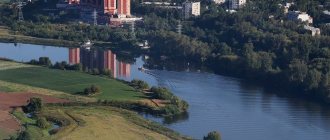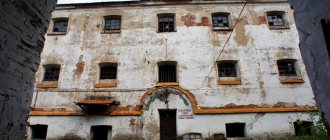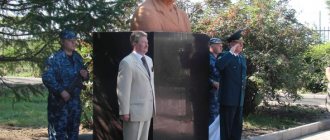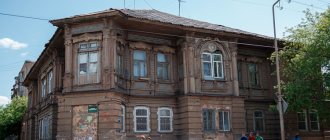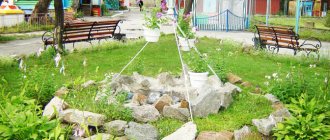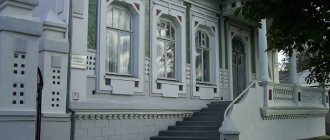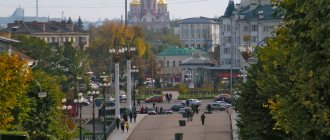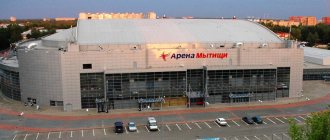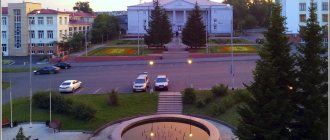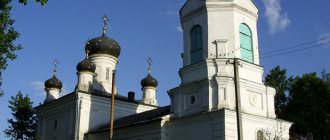Architecture of Mogilev
Church of the Three Saints , located on the street. Pervomaiskaya, is the main Orthodox church of the city.
The cathedral is named after three saints - Basil the Great , John Chrysostom and Gregory the Theologian . This is an elegant building, built in the shape of a cross, decorated with seven beautiful domes.
A special property of the temple is the list of the miraculous icon of the Mother of God “Mogilev-Bratskaya”. There are other revered shrines here.
Holy Cross Cathedral , which is also one of the main attractions of the city, is a single complex that unites the cathedral itself and the St. Boris and Gleb Church.
The history of these buildings goes back to the distant past - to the 17th century. The temple was destroyed many times, rebuilt, renamed and closed.
Since 1946 , the church has been in operation and continues to delight visitors not only with its unique atmosphere, but also with the beauty of its architecture.
The Cathedral Church of St. Stanislaus is another important religious building in Mogilev. The church has a rich history, shrouded in secrets. They say that it previously belonged to the famous Carmelite order. Built back in the 17th century, it stood in a wooden “vestment” for 100 years. There is a legend that over time, the Polish king issued a decree that the city residents undertake to dismantle all stone buildings and, using this stone, build a church.
The temple received its beautiful stone appearance in 1752 . To this day, it pleases the eye not only with its baroque architecture, but also with its pictorial cycles on gospel subjects.
You will find the cathedral at st. Komsomolskaya, 4.
We also recommend visiting:
- Headquarters building (Sovetskaya Sq.);
- Palace of George Konissky (Leninskaya St.);
- Complex of St. Nicholas Church (Surty St., 19);
- City Hall (Leninskaya St., 1a);
- Square of Stars (Leninskaya St.);
- Sovetskaya Square (lane Pervomaiskaya and Chelyuskintsev streets);
- Mogilev Castle (Chelyuskintsev St.);
- Mogilev Regional Drama Theater (Pervomaiskaya St.).
Sights of the Mogilev region
The Mogilev region is rich in historical attractions. It includes several ancient cities that can be explored while traveling around this region.
The city of Bobruisk attracts special attention. Here tourists can explore the remains of the Bobruisk fortress. The structure was erected more than 200 years ago, on the eve of the war with Napoleon. Casemates, bastions, barracks and other premises have survived to this day. Today the fortress is abandoned, but this does not stop history buffs from coming here on their own and examining the remains of the great structure.
Also in Bobruisk you can see a monument to Beaver. It is noteworthy that the city got its name thanks to this animal. From time immemorial, local residents hunted beavers, so the animal was the only breadwinner for the townspeople. Local residents believe that if you rub the monument and make a wish, it will definitely come true. Interestingly, there are several more monuments to this animal in the city. In residential courtyards and parks you can see a beaver on a bench or see a wooden sculpture of the animal.
Arriving in the Mogilev region, be sure to visit the city of Bykhov . Here is the unique architectural monument of the Chodkiewicz and Sapieha Castle. The structure dates back to the 16th century. In those days, the castle played the role of a defensive structure that could hold back the most furious sieges of the city for a long time. Today the castle is under reconstruction, but this does not prevent tourists from visiting it.
Another place where you can go on your own is the village of Zhilici . Here, surrounded by a huge forest park, lies the unique Bulgakov estate. No, this is not the home of a famous writer, the Bulgaks are not related to Bulgakov, they were significant political figures in the history of the region. The palace is famous for its unique architecture, artificial ponds and exotic plants planted in the park. Nowadays, active restoration of the castle is underway. It already houses an art school and a museum, and the temple is being renovated. This place is a favorite for newlyweds to take photo sessions.
Just 15 km from Mogilev there is a small village of Knyazhitsy . The Church of St. Anthony is located here. The building is unique in its architecture and rich history. The first monastery was built of wood; later, during numerous restorations and repairs, a stone palace was erected. In 1832 the monastery was closed, and 50 years later it was converted into an Orthodox church. However, the temple was also abandoned; since 1965 it no longer received parishioners and its bells are still silent. Today the building is considered unsafe and can only be inspected from the outside.
Museums of Mogilev
The Mogilev Museum of Local Lore is one of the most popular in the city. It was here, in addition to ancient icons, books and precious jewelry, that the silver mace of King Sigismund III and the national relic of Belarus - the cross of Euphrosyne of Polotsk - were once kept. During World War II, most of the exhibits, unfortunately, burned down along with the museum building.
Now the museum's exhibition includes more than 300 thousand objects showing the nature and history of the region.
The museum is located at Sovetskaya Square, 1.
In the famous City Hall of Mogilev there is a museum of the history of the city . The museum's exhibition includes more than 8 thousand valuable objects, including weapons and labor items from the Stone Age, Slavic amulets, amulets, jewelry and moonlights.
It also houses a large collection of rare early printed books and scrolls. There is a permanent exhibition dedicated to the history of Christianity, which displays crosses, icons and church utensils.
The museum also has a section on the Great Patriotic War, an art section and an exhibition dedicated to traditional Belarusian clothing.
The ethnographic museum “Belarusian Village of the 19th Century” , located in the village, enjoys well-deserved popularity among tourists Buynichi near Mogilev.
The museum features a pottery, a bakery, a weaver's, carpenter's and blacksmith's workshop, as well as a weaving house made of straw and wicker. Here you can get acquainted with the traditional way of life and crafts of the 19th century. and purchase works by local artists.
You will also see a windmill, beautiful stone compositions and fountains. There is a children's playground on the museum grounds.
We also recommend visiting:
- Maslennikov Art Museum;
- Mogilev Museum of Ethnography;
- Fire Service History Museum;
- Byalynitsky-Birulya Museum.
Belarusian ethnographic village
It is a stylized village of the 19th century.
Can see:
- life,
- customs,
- rituals of that time among Belarusians.
You can also visit:
- potter's house,
- baker,
- blacksmith
You can walk around the territory, you will definitely find gifts and souvenirs here. From the outside, it all looks like a real village, where they brew moonshine, which you can taste, prepare porridge and eat it with a wooden spoon, you can try forging or making pots.
The place is intended for a pleasant time, to go back 2 centuries and try your skills.
City monuments
The most famous sculpture of Mogilev is the composition “Stargazer” , located on the street. Leninskaya square Stars The sculpture is beautiful and unusual. It is an image of an astrologer sitting on a chair and pointing his finger at the sky. Nearby there is a telescope in which a spotlight lights up at night.
The astrologer's chair is surrounded by 12 chairs that symbolize the signs of the zodiac.
There is a legend that if you sit in the chair of your zodiac sign and make a cherished wish, it will definitely come true.
In the vicinity of Mogilev in the village. Buinichi there is another famous monument - the Buinichi Field memorial . The monument is dedicated to the soldiers who, back in 1941, defended Mogilev from the conquerors for 20 days here.
The memorial covers an area of 20 hectares. In its center there is a chapel 27 meters high, connected by an alley to the main entrance arch. Also on the territory of the memorial there is an exhibition of military equipment from the Great Patriotic War.
You can also see the following monuments and sculptures:
- "Tomb of the Lion";
- Stationmaster;
- Memorial Chapel in the village of Lesnaya;
- Memorial complex in the village of Sychkovo.
Train Station
Mogilevsky station is quite friendly, very clean and tidy. The building is made in neoclassical style. The central dome of the station is completely glazed, so the room is very bright. Two glazed corridors extend from the dome to the right and left, complementing the lighting. The building is made in beige and white colors at the moment. Of course, during the war years it had to undergo certain destruction and changes.
Residents had to ask for the construction of a railway for a long time. Mogilev is a trading city, goods were sent by river, but it was simply impossible to get to all places. Therefore, only in the 20th century it was decided to lay railway tracks. But travel was not available to everyone; it was cheaper to travel on horseback.
Parks of Mogilev
One of the best places for walks in Mogilev is the Pechersky Forest Park on the street. Surganova. Here you can not only walk along landscaped forest paths, but also relax by the picturesque lake, sunbathe, swim and go boating.
Here are some more cozy places in Mogilev:
- Moscow courtyard;
- Tula courtyard;
- Embankment of the river Dubrovenka;
- Polykovichi krynitsa;
- Palace and park complex (village Zhilici).
Bridge over the Dnieper River
Until the mid-19th century, there was no concept of a bridge in Mogilev; people crossed either on rafts or on ferries. However, the city grew, new needs arose, and the issue with the bridge became quite pressing.
In 1862, the first wooden bridge was erected, which at that time was a strong engineering structure. Over time, additional farms were installed and it was strengthened, but it did not survive the war years. Years have passed and only to this day a strong, reliable bridge has been installed connecting both banks of the Dnieper.
What you can see in Mogilev in one day
- We suggest starting the tour from the Mogilev City Hall , located on Glory Square (aka Sovetskaya).
- If you wish, you can visit the city history museum , located in the Town Hall building.
- Then you can walk along the street. Lenin. Here you can see the curious Tula and Moscow courtyards and the famous Square of Stars with the Astrologer sculpture in the center.
- Also on the street. Lenin you will find the palace of G. Konissky .
- Nearby is the beautiful building of the Drama Theater and the Church of St. Stanislava .
- Further along the street. On Pervomaiskaya you can go to the Church of the Three Saints .
- We also suggest visiting the St. Nicholas Monastery and the Cathedral of St. Nicholas .
- If you have time and energy left, you can go to the village. Buynichi , where you will also find many attractions.
- In the evening you can relax by walking and enjoying the silence in the Pechersk Forest Park . And when it gets dark, we suggest returning to the Square of Stars and seeing how a pillar of light rushes into the sky from a stargazer’s telescope.
Moscow courtyard
St. Nicholas Convent
The monastery is white on the outside, with narrow, high windows.
When visiting the monastery, you must follow strict rules. A woman should have her head covered, and a man without a headdress.
The history of the monastery is difficult and sometimes unpleasant. They say that a lot of people were buried there during the war.
The monastery is fenced with a high white stone wall, its walls are painted with the faces of saints. The interior decoration is amazing. The wooden gilded iconostasis is skillfully made by wood carvers and gilders. Once inside, you calm down, looking up at the paintings on the walls and dome, peace sets in. The courtyard at the monastery is well-groomed, neat, it’s pleasant to be and walk there.
What to see in Mogilev in 2 days
If you decide to get to know this wonderful city on the weekend, we offer a list-route of places where you can go in Mogilev and the surrounding area on the weekend.
1 day
- If you got to Mogilev by train, we suggest starting to explore the city from the ancient railway station . You can also see a sculpture of a stationmaster here.
- We take the trolleybus and get to the Church of the Three Saints .
- After visiting the church we go to the square. Lenin, where you will see the monument and the House of Soviets .
- Next we go along the street. May Day and immediately we find the Church of St. Stanislava .
- We move further and see the Drama Theater. Near him is a cute statue “Lady with a Dog” .
- Let's go to the street. Lenin. Walking along this street, you will come out onto the square. Stars with the famous monument “Stargazer” .
- A little further - the Moscow courtyard and the palace of G. Konissky .
- We go out to Sovetskaya Square, in the center of which there is a memorial to WWII soldiers. Here is the famous City Hall , inside of which there is a historical museum.
- Not far from the square are the ruins of the Mogilev Castle .
- From the square you can go to the river embankment. Dubrovenka , a walk along which you can enjoy the rest of the day.
Palace of G. Konissky
Day 2
- We propose to devote the main part of this day to a trip to the village of Buynichi . You can get here by minibus coming from the square. Soviet. or by local train.
- First of all, we advise you to visit the famous Buinichi Field memorial .
- Across the road from the memorial is the city zoo . You can order here if you wish.
- The complex “Belarusian Village of the 19th Century” is also located nearby .
- Then you can return to Mogilev, visit one of the city’s art museums and take a walk through the Pechersky Forest Park .
- Or you can go to the Polykovichi spring and collect healing water as a souvenir.
Belarusian village of the 19th century
Polykovichi spring
Zoo
A visit to the zoo will be especially interesting for children. The zoo has predators, mammals, ungulates, birds, domestic animals, and the pride is the bison. The territory of the zoo is large enough to take a walk.
The zoo itself was founded in 2005, the initiators were teachers and students of the agroforestry college. You can purchase tickets for a railway safari, which is a trip through the park, where they talk about the park and its inhabitants.
After visiting the zoo, you can go to the nearby Korchma complex, where you can visit the city of craftsmen:
- pottery,
- forge,
- bakery.
Next, you can visit the city’s defense line – Buinichi Field.
Osipovichi
One of the largest transport hubs in Belarus arose at the end of the 19th century in connection with the construction of the Libavo-Romenskaya railway . It is no coincidence that the steam locomotive became part of the history of the city and a symbol on its coat of arms, and in 2002, in honor of the 130th anniversary of the city, one of the real rare locomotives that was used at the station was installed on a pedestal near the station. Other attractions of the city include the station buildings, an ancient water tower, buildings of the late 19th - early 20th centuries, as well as a beautiful monument of wooden architecture - the Holy Cross Church , built in 1826 in the village of Zborsk and transported in 1946 to Osipovichi.
from Mogilev – 160 km, from Minsk – 108 km
Bykhov Castle
The calling card of the ancient city is the outstanding architectural monument Bykhov Castle , which was erected by Hetman of the Grand Duchy of Lithuania Jan Karol Chodkiewicz. The powerful citadel was surrounded by earthen ramparts and a ditch with water, and fortified with defensive towers. But besides the fortress walls, there was a majestic palace building, where the owners’ chambers and a luxurious crown hall for meetings, sessions and balls were located. In 1628, the palace and castle ensemble passed into the hands of Lev Sapieha and was significantly rebuilt. During its history, the castle has survived many military events: fragments have survived to this day, and now the only surviving fortress city of the 17th century in Belarus is under restoration.
Other attractions of Bykhov include the ancient Holy Trinity Church and the unique defensive synagogue of the 17th century .
Bykhov
Healing springs
In the Mogilev region, like nowhere else, there are many miraculous water sources. The most famous of them is the Blue Krynitsa, or Blue Well, near the village of Kliny, this is the largest spring in Belarus. The water comes from a mine about 300 meters deep, creating a small lake with blue water that never freezes. Every year on August 14, pilgrims come to the spring en masse; a chapel and crosses are installed here.
In the suburbs of Mogilev there is the Polykovichi spring, known since 1552. Even then, local residents appreciated the magical properties of water. The patron saint of the spring is considered to be the holy martyr Paraskeva, who is the guardian of marriage and the family hearth. In the last century, every girl who asked Paraskeva for protection made a pilgrimage to the source. Today, the spring is visited by thousands of pilgrims and tourists, especially newlyweds.
There are healing springs in the Pustynki mentioned above, as well as in the villages of Prusino, Gamarnya, Usokha and other places.
Dandelion fountain
And we move on and see a very original “monument” to the dandelion - a fountain.
Excursion to Mogilev
The dandelion turned out like a real one: so tender and airy. It seems that you blow on it, and the breeze will carry its light umbrellas to different parts of the planet... I really like this fountain
City Hall
The Town Hall existed on Gubernskaya Square (present-day Glory Square) for a long time and was destroyed in 1957. In 2008, the newly built Town Hall was opened. There is a museum of the city of Mogilev here. Its halls display exhibits from the 9th to the 20th centuries, giving an idea of the life of townspeople of various classes.
The observation deck offers views of the Dnieper River and the city. Under the very dome of the town hall there is a tower clock that rings every hour, telling the time to the townspeople. The clock mechanism is serviced by a master watchmaker. Every day he walks up to the town hall to monitor the operation of the main city clock.
Address: Leninskaya street-1A.
Shklov
The “cucumber capital” of Belarus is famous for its rich harvests of the vegetable, which locals have been growing since the 16th century, and every year in August it celebrates Cucumber Day . The central square of the city is decorated with the sculptural composition “Cucumber” and a monument to the famous favorite of Catherine II Semyon Zorich , who founded a noble school, a theater, a ballet and music school in Shklov , built a luxurious palace and a huge greenhouse for balls and masquerades, and founded the Church of the Transfiguration. Today, the main attraction of the city is the town hall - an architectural monument of the late 18th century, erected along with shopping arcades. Its high faceted tower is decorated with an ancient clock, and the spire is crowned with the coat of arms of Shklov.
On the outskirts of modern Shklov, at the bend of the Dnieper River, archaeologists discovered a “disappeared” old town with a castle , where every year they continue to discover new historical layers and make amazing finds. Among them are the castle watchtower and the master's house, the ruins of the Church of the Resurrection and the Dominican monastery, and many artifacts of the 17th century.
from Mogilev – 35 km to the north, from Minsk – 244 km
Writers and artists of the Mogilev region
Many famous figures of Belarus were born and worked in the Mogilev region. For example, in the village of Malaya Bogatkovka, Mstislavsky district, the writer and literary critic Maxim Goretsky was born. The literary museum appeared in Maxim’s father’s house. Today, one of its halls is dedicated to the work of Goretsky, and in the second the typical interior of a rural house of the early 20th century is recreated. By the way, the initiator of the creation of the Maxim Goretsky Museum was Vladimir Korotkevich.
The village of Novye Samotevichi, Kostyukovichi district, is famous for the birthplace of the poet Arkady Kuleshov. To be precise, the poet lived in the village of Samotevichi, but the village disappeared from the map of Belarus after the accident at the Chernobyl nuclear power plant. Today, only the ruins of a huge church remain in the ghost village. All residents of the town were moved to places nearby that were not so heavily contaminated with radiation. This is how the village of New Samotevichi appeared. Today, a museum dedicated to the famous fellow countryman has been opened at the local school.
The famous landscape painter Witold Byalynitsky-Birulya was born in the Belynichi district. The artist especially loved spring; he has more than 200 spring landscapes. In honor of Byalynitsky-Biruli, museums were opened in Belynichi and Mogilev.
